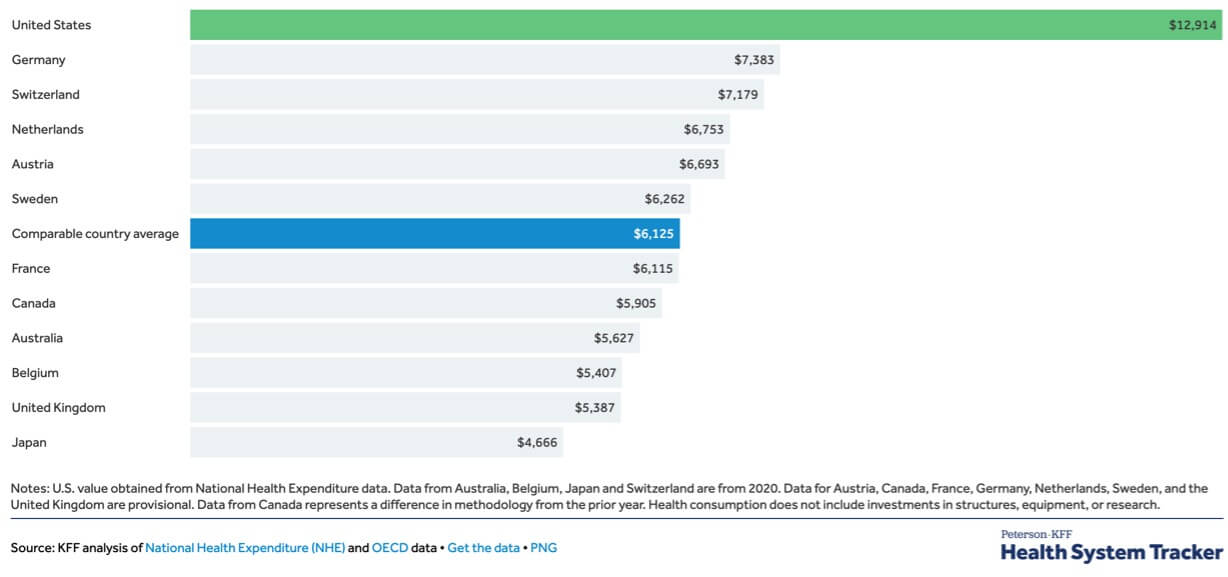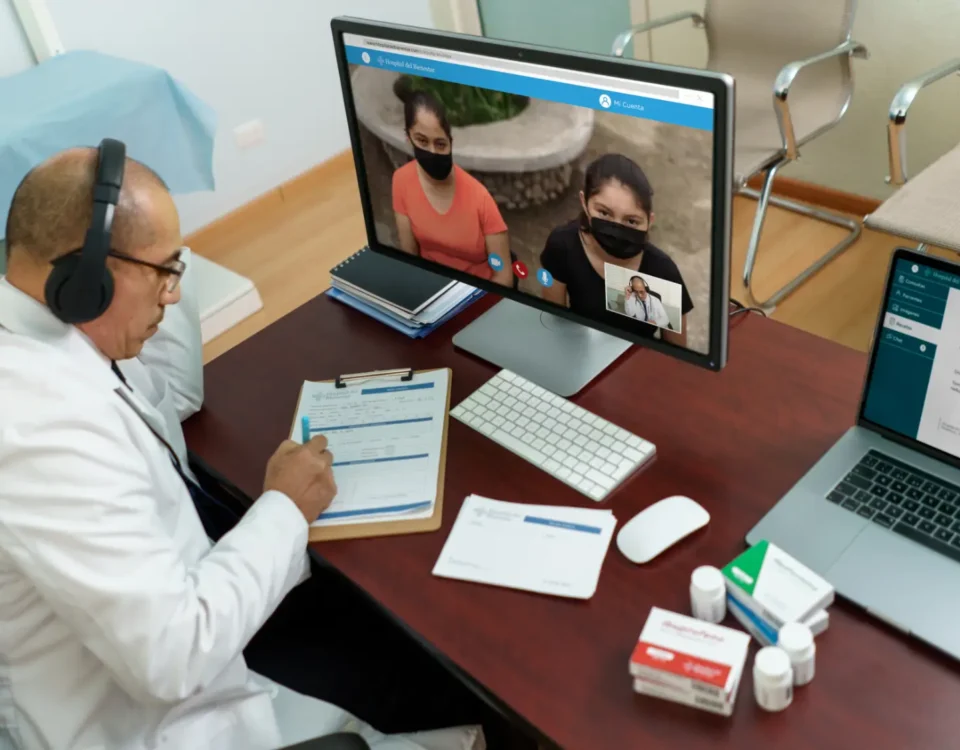
CASE STUDY: Providing Medical Support on the High Seas
May 9, 2023
New Frontier Group Achieves ISO 9001 Certification
October 10, 2023US Healthcare - The Elephant in the Room
A New Frontier Group US Healthcare Report - 2023
When it comes to travel medical insurance, there’s an undeniable truth that can’t be ignored—the United States. It is no secret that the cost of healthcare is significantly higher when visiting or residing in the United States compared to other countries. This unavoidable reality has made the United States the proverbial "elephant in the room" of travel insurance costs.
See Exhibit 1 for Health System Tracker recent data on US cost compared to other countries.
Exhibit 1: health expenditure in U.S. dollars

And despite these costs – the outcomes are not getting better.
Despite much higher cost, US has:
- lower life expectancy
- higher rates of chronic diseases
- overall lower outcomes of care
I. Five Key Cost Drivers
There are numerous and complex factors that feed this elephant and keep costs rising without improving quality. Below are 5 of these key drivers of costs that can be mitigated with the right processes in place:
1. Complex Payment Structure: Healthcare providers must manage hundreds of private pay, commercial and government billing and reimbursement arrangements. This complexity leads to high administrative costs and adds inefficiency to the system.
2. High Drug Cost: Pharmaceutical companies often charge significantly higher prices for prescription drugs compared to other countries. There is a lot of ongoing legislation and US political emphasis and conflict around high drug costs in the US. It is good to be sure anyone coming to the US understands how drugs work on their plan.
3. Lack of Price Transparency: Another ongoing challenge in US healthcare is the lack of price transparency. It is especially difficult for non-US citizens to obtain clear information about the cost of medical services, including consultations, procedures, and medications. The lack of pricing availability makes it difficult to compare costs and make informed decisions.
4. High Cost of Procedures and Tests: Medical procedures and diagnostic tests in the US tend to be more expensive compared to other countries due to higher labor costs, advanced medical technology, and the profitability-driven nature of the healthcare industry. The costs associated with hospital stays, surgeries, imaging tests, and other medical procedures contribute significantly to the overall healthcare expenses.
5. A Fragmented System: The US healthcare system is characterized by fragmentation, where healthcare services are delivered by various independent providers, hospitals, and insurance companies. This fragmented structure results in a lack of coordination and continuity of care, which can lead to inefficiencies and increased costs. The absence of a unified system hampers the ability for cost-saving measures and streamlined delivery.
II. Highest Cost US Cities
The cost of healthcare can vary across different cities in the United States. However, some cities are generally known for having higher healthcare costs due to factors such as:
- Higher living expenses
- Concentration of specialized medical facilities
- Regional market dynamics
Here are the top 5 cities that have been historically associated with higher healthcare costs in the US over the last 10 years:
1. San Francisco, California: San Francisco is known for its high cost of living, and healthcare expenses are no exception. The city has a significant concentration of renowned medical institutions, which can contribute to higher healthcare costs.
2. New York City, New York: New York City is home to some of the top-ranked hospitals and medical centers in the country. The cost of healthcare in this densely populated city tends to be higher due to a combination of factors such as high demand, specialized services, and operating expenses.
3. Boston, Massachusetts: Boston is renowned for its world-class medical institutions and is a hub for cutting-edge healthcare research. The presence of prestigious hospitals and medical schools can contribute to higher healthcare costs in the city.
4. Los Angeles, California: Los Angeles has a large and diverse healthcare market, ranging from high-end specialized clinics to community health centers. While healthcare costs can vary depending on the specific services needed, the overall cost of healthcare in Los Angeles tends to be higher than the national average.
5. Miami, Florida: Miami is known for its thriving healthcare industry, with a significant number of hospitals, clinics, and medical tourism. The cost of healthcare in Miami can be higher due to factors such as the high concentration of specialized medical services and a large population of retirees.
It is important to note that healthcare costs can change over time and can also vary greatly by procedure, so this information may not reflect the most up-to-date situation in each of these cities. We also do research and consult local healthcare providers for the most accurate and current information regarding healthcare costs in specific cities prior to advising clients on any specific issue.
III. Volume of Non-US Citizen / Traveler Healthcare
It's important to note that the top 5 highest cost cities discussed above also manage high volumes of travel medical insurance and IPMI cases. This is typical because they are high travel areas and they have a good reputation for healthcare and healthcare infrastructure. In addition to the 5 high-cost cities above, two additional cities with high volume of travel care include the following:
1. Cleveland, Ohio: Cleveland is known for its excellence in healthcare, particularly in areas such as cardiology, orthopedics, and cancer treatment. The city is home to renowned medical institutions and attracts patients seeking specialized care.
2. Chicago, Illinois: Chicago has a robust healthcare sector, with world-class medical facilities and specialized centers of excellence. The city attracts patients from around the world for a wide range of medical treatments and procedures.
This data varies over time and depends on the specific circumstances and procedure. When advising clients for up-to-date information on the highest volume cities for travel medical insurance and IPMI in the US, we consult with our insurance provider partners, medical tourism agencies, and other healthcare organizations specializing in medical travel.
IV. Lowest Cost US Cities
Here are the top 5 cities that have been historically associated with lowest healthcare costs in the US over the last 10 years:
1. El Paso, Texas: El Paso is often cited as one of the cities with relatively lower healthcare costs. The city has a lower cost of living compared to many other metropolitan areas in the country, which can translate to more affordable healthcare services.
2. Albuquerque, New Mexico: Albuquerque is known for its lower cost of living, including healthcare expenses. The city has a relatively low physician density, which may contribute to lower healthcare costs compared to larger metropolitan areas.
3. Oklahoma City, Oklahoma: Oklahoma City is often mentioned as a city with lower healthcare costs. The cost of living in Oklahoma City is generally lower than the national average, which can extend to healthcare services.
4. Indianapolis, Indiana: Indianapolis is recognized for having a lower cost of living compared to many other major cities in the United States. This can potentially translate to more affordable healthcare costs.
5. Louisville, Kentucky: Louisville is often considered as a city with relatively lower healthcare costs. The cost of living in Louisville is generally lower compared to national averages, which may result in more affordable healthcare services.
As stated earlier, it is important to note that healthcare costs can change over time and can also vary greatly by procedure, so prior to advising clients on any specific issue we always seek clarification.
V. Resolving High-Cost Drivers / Improving Outcomes
Addressing these factors is crucial to tackling the high cost of healthcare and improving outcomes in the United States – regardless of the city where care is delivered. Below are some of ways New Frontier Group works with clients today to mitigate the underlying factors contributing to the high cost of healthcare in the United States.
1. Resolving Complex Payment Structures: New Frontier Group helps streamline administrative processes by implement efficient systems for claims processing, billing, and other administrative tasks to reduce paperwork. We also invest in the latest in technology and provide digital platforms for claims management, and automated systems to streamline administrative tasks and reduce manual errors.
2. Resolving High Drug Prices: New Frontier Group leverages contracts it has with pharmacies for lower drug prices We integrate a full pharmacy concierge service into cost management that focuses on medications discounts and seamless drug transitions when travelers need ongoing medication for travel home.
3. Resolving High-Cost Procedures/Tests: New Frontier Group offers cost containment strategies such as case management programs to ensure appropriate and evidence-based use of medical procedures and diagnostic tests, reducing unnecessary or duplicate services. We also offer telehealth solutions and for some procedures we have negotiated flat rate contract pricing with providers to promote price transparency and offer cost-effective services. We help with the selection of providers based on price and quality to lower costs.
4. Resolving Lack of Price Transparency: New Frontier Group not only encourages healthcare providers to be more transparent about their pricing by requesting detailed cost breakdowns and advocating for price transparency regulations, but we also have flat rate transparent all-encompassing agreements with some of the top providers in the US. Additionally, we offer cost estimation that provides information on the cost of procedures, tests, and medications, helping everyone make informed decisions about the options available.
5. Resolving a Fragmented System: We partner with the top provider networks in the nation to offer services at highly negotiated rates and also ensuring better coordination and continuity of care while minimizing costs. We not only offer the networks but we also collaborate closely with providers and organizations to promote care coordination initiatives, such as care management programs and care teams, to ensure seamless transitions and reduce unnecessary healthcare utilization.
VI. Summary
The "US Healthcare - The Elephant in the Room" written by New Frontier Group highlights the significant cost disparities and challenges associated with healthcare in the United States. The report emphasizes the high cost of healthcare in the US compared to other countries, making it a prominent concern in travel medical insurance.
The report identifies five key drivers of rising healthcare costs in the US, including complex payment structures, high drug costs, lack of price transparency, high cost of procedures and tests, and a fragmented healthcare system. These factors contribute to inefficiencies, administrative burden, and increased expenses within the healthcare system, without necessarily improving outcomes.
Furthermore, the report discusses the variation in healthcare costs across different cities in the US. It identifies cities such as San Francisco, New York City, Boston, Los Angeles, and Miami as historically associated with higher healthcare costs due to factors such as high living expenses, concentration of specialized medical facilities, and regional market dynamics. Conversely, cities like El Paso, Albuquerque, Oklahoma City, Indianapolis, and Louisville have been known for relatively lower healthcare costs.
To address these cost drivers and improve outcomes, the report suggests several strategies. These include streamlining complex payment structures, leveraging contracts for lower drug prices, implementing cost containment strategies for procedures and tests, promoting price transparency, and focusing on care coordination initiatives within a fragmented system.
The report concludes that understanding and addressing these factors are crucial in mitigating the high cost of healthcare in the US and improving outcomes. New Frontier Group offers various solutions to resolve these challenges, including efficient administrative processes, pharmacy concierge services, cost containment strategies, price transparency, and collaboration with provider networks to enhance care coordination while minimizing costs.
Making the right choice in US healthcare, takes partnerships and communication to ensure care is managed in the right place with the most reputable providers focused on the best outcomes.





